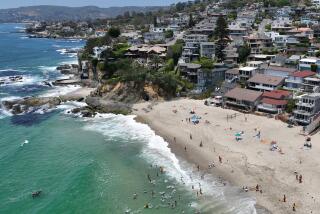Getting to the Source of the Problem : Stopping Spills Before They Taint Ocean Makes More Sense Than Simply Reacting
Orange County at times seems remarkably slow to reckon fully with all the implications of ocean pollution. The water is a resource around which so many other things depend that make this a special place to live and visit. And yet, as we have noted in previous years, closed beaches and fouled water too often have been regarded as part of the cost of having runoff from the newly developed South County communities.
Fortunately, it appears now that some local officials are getting fed up enough that they aren’t going to take it anymore, to paraphrase the famous line from the movie, “Network.” Three Laguna Beach City Council members have asked for public hearings before the Aliso Water Management Agency, the regional agency for waste and water districts that serves a number of nearby communities.
These officials rightly want to know why more can’t be done to stem the pollution problems arising from urban runoff at the mouth of Aliso Creek, which is part of a drainage basin from inland cities.
It’s a good question, and it was encouraging to see the general manager of the South Coast Water District, the agency with jurisdiction at the mouth of the creek, acknowledge that ocean quality in the area is poor and that better efforts are called for. There are a number of components, including recycling more water, finding new drainage alternatives, and increasing public awareness of the consequences of careless dumping into inland drainage systems that later end up in the ocean.
During the winter, rainfall almost routinely is followed by spills that close beaches and threaten wildlife. Although heroic efforts often have been made in the past in South County to fix broken pipes once the damage is done, it is necessary to be more anticipatory in order to cut down on spills before they occur.
In 1992, the popular Aliso Beach was closed for what appeared to be an interminable amount of time. In June of this year, a one-mile stretch of the beach had to be closed after 16,000 gallons of partially treated sewage spilled into the creek and flowed into the ocean.
Clearly, living with the prospect of spills as a way of life needs to be changed.
The concern of the local officials suggests a welcome willingness to take more direct action to prevent such problems. Cooperation between local representatives and the responsible agencies can be an effective start in heading off future problems, and changing the way people think about ocean pollution.
More to Read
Sign up for Essential California
The most important California stories and recommendations in your inbox every morning.
You may occasionally receive promotional content from the Los Angeles Times.










